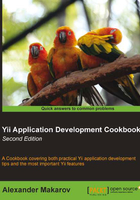
Using exceptions
Exceptions are a core PHP feature, but they are seldom used fairly. Yii makes exceptions very useful.
There are two main areas where Yii exceptions come in handy, which are as follows:
- Exceptions allow the simplifying of the process of detecting and fixing application errors and special situations, such as database connection failure or API failure
- Exceptions allow the generating of different HTTP responses in a very clean way
Generally, an exception should be thrown when a component cannot handle a special situation, such as the one said earlier, and needs to leave it to higher-level components.
How to do it…
- Let's assume that we have an
application/apis/lyrics/LyricsFinder.phpclass that makes an HTTP request to an API using CURL and returns lyrics for a song based on its name. This is how we can use exceptions inside of it:// create some custom exceptions to be able to catch them // specifically if needed // general lyrics finder exception class LyricsFinderException extends CException {} // used when there is a connection problem class LyricsFinderHTTPException extends LyricsFinderException{} class LyricsFinder { private $apiUrl = 'http://example.com/lyricsapi&songtitle=%s'; function getText($songTitle) { $url = $this->getRequestUrl($songTitle); $curl = curl_init(); curl_setopt($curl, CURLOPT_URL, $url); curl_setopt($curl, CURLOPT_RETURNTRANSFER, 1); $result = curl_exec($curl); // if there is an HTTP error, we'll throw an // exception if($result===false) { $errorText = curl_error($curl); curl_close($url); throw new LyricsFinderHTTPException($errorText); } curl_close($curl); return $result; } private function getRequestUrl($songTitle) { return sprintf($this->apiUrl, urlencode($songTitle)); } } - As we don't know how a specific application needs to handle its API connection, we will leave it to the application itself by throwing a custom exception
LyricsFinderHTTPException. This is how we can handle it in ourprotected/controllers/TestController.phpclass:class TestController extends CController { public function actionIndex($song) { $lyric = 'Nothing was found.'; // importing api class Yii::import('application.apis.lyrics.LyricsFinder'); $finder = new LyricsFinder(); if(!empty($song)) { // We don't want to show user an error. // Instead we want to apologize and // invite him to try again later. try { $lyric = $finder->getText($song); } // we are looking for specific exception here catch (LyricsFinderHTTPException $e) { echo 'Sorry, we cannot process your request. Try again later.'; } } echo $lyric; } } - Another usage of Yii exceptions is the generation of different HTTP responses by throwing
CHttpException. For example, an action that displays a blog post represented by aPostmodel loaded by its ID will look like this:class PostController extends CController { function actionView() { if(!isset($_GET['id'])) // If there is no post ID supplied, request is // definitely wrong. // According to HTTP specification its code is 400. throw new CHttpException(400); // Finding a post by its ID $post = Post::model()->findByPk($_GET['id']); if(!$post) // If there is no post with ID specified we'll // generate HTTP response with code 404 Not Found. throw new CHttpException(404); // If everything is OK, render a post $this->render('post', array('model' => $post)); } }
How it works…
Yii converts all non-fatal application errors to CException automatically.
Additionally, the default exception handler raises either the onError event or the onException event. The default event handler writes a log message with the error level set to error. Additionally, if your application's YII_DEBUG constant is set to true, unhandled exceptions or errors will be displayed at a handy error screen. This screen includes a call stack trace, a code area where the exception was raised, and the file and line where you can look for the code to fix.
There's more...
For further information, refer to the following URLs: